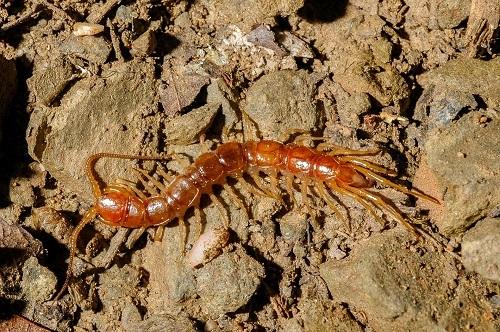Forest arthropods and rivers: an unknown connection

Credit: Antoni Serra, UNIVERSITY OF BARCELONA-CRBA
The structure of vegetation and steam distance are important factors to consider in order to protect the biodiversity of forest arthropods, as stated in an article now published in the journal Forest Ecology and Management. The conclusions of the study note the farther we are from a river course, the better conditions for the communities of arthropods in the forests, since they need a cool and wet microclimate.
The new study is led by experts from the Faculty of Biology, the Biodiversity Research Institute (IRBio) and the Animal Biodiversity Resource Center of the University of Barcelona (CRBA), and it counts on the participation of experts from CREAF-UAB, the Museum of Natural Sciences of Barcelona, and the universities of Canberra and Melbourne (Australia).
Forest arthropods and rivers: a connection to be discovered yet
An almost unknown ecological relationship so far, that is the inflow of the presence of a river in the biodiversity of non-riparian forest arthropods. This is the new ecological perspective the article treats in order to study the population of arthropods in forest areas in the northeastern area of the peninsula, in O Incio (Lugo, Spain).
The great biodiversity of analyzed arthropods in the study -twenty-one orders and sixty families- expands the reference coordinates in previous studies that were mostly focused on specific groups, such as butterflies. “It is known that rivers are vertebral axes of terrestrial ecosystems, they regulate the microclimate and have many ecosystemic values. However, the relationship with forest arthropods -beyond gallery forest ones- was not quantified”, notes the first author of the article, researcher Sergio Albacete, from the Department of Evolutionary Biology, Ecology and Environmental Sciences of the UB.
The new study puts emphasis on the value of discovering the biology of relatively unknown groups, “such as flies, dipteral insects with more than a hundred families in the Iberian Peninsula, and which are important for the processes of pollination, decomposition and plague control”, notes the researcher.
Chestnut woodlands: ecology, economy and landscape
The studied forest areas in the study are chestnut woodlands (Castanea sativa), “habitats with a great ecological economic and landscape value”, says researcher Alberto Maceda (UB-IRBio). “From a biological perspective, we find centenary trees and a great biological diversity that has been preserved over the years thanks to the traditional management, an activity which is being lost due to rural abandonment. These trees have economic value as well, since they provide fruit and wood, subsistence resources for the rural world in the past. As landscape, soutos -local name for the chestnut trees- are protected by the Directorate habitat, and are the dominant landscape of many valleys”.
According to the conclusions, the distance between the trees and the rivers affects the richness, abundance and trophic guilds of the arthropods “after considering other factors (level of coverage of the understory, diversity and height of plants, density and diameter of the trunks, etc.) that affect the availability of food and shelter for these invertebrates”, says Sergio Albacete. “Therefore, we have to consider the effects of such distance to establish ecological relationships between the arthropods and the rivers”.
Everything points out to the fact that social wasps are the most affected group by the steam distance. “Without setting potential cause-effect relationships, the statistical analysis of individual effects in several studied variables would suggest social wasps do not like to live far from rivers”, reveals Alberto Maceda. “We are now studying this relationship in detail, since we have been getting samples of the Asian wasp (Vespa velutina) since 2017. This invasive species is generating a social alarm and can affect the conservation of the native biodiversity”.
A traditional management for the richness of understories
In order to protect the forest diversity of the arthropods -some of which control many agricultural and forest plagues in a natural way-, we would need to preserve the traditional management of forests, favour the richness of understories and maintain the chestnut tree as the predominant tree in the area. Another important factor would be to avoid clearance of paths -which eases chestnut gathering- before the end of the plant period of the understory.
“The traditional management -regarded as a medium-intensity perturbation- prevents the understory from being monopolized by plants with an extensive growth (blackberries, ivy, fern, etc.). Moreover, this management model prevents soutos from densifying due to the growth of the chestnut trees and the germination of other trees in the forest”, notes Maceda.
In this habitat, the presence of oaks near the chestnut trees “is essential to control the chestnut gall wasp (Dryocosmus kuriphilus), since we can find deformations of plant organs where native parasites reproduce -other wasps- and control the plague of the chestnut tree which also provokes these”, highlights the lecturer Juli Pujadé Villar, from the Department of Evolutionary Biology, Ecology and Environmental Sciences of the UB.
Discovering the structural complexity of the forest
Arthropods are the animal taxon with the largest diversity worldwide. However, we need to conduct many studies on different groups in several habitats to complete the general view of the conservation state of these invertebrates. At the moment, habitat loss, alterations in the phenology of plants due to climate change and the use of pesticides are threatening the conservation of many groups of arthropods worldwide.
“It is important to improve the management of the understories in a moment in which society thinks a forest is dirty when it has understory and the fire prevention policies lead to random clearances to clean it. We need more pedagogy at school -since studying biodiversity is getting a lower value- so that society understands a forest has a structural complexity a garden does not have, and we need to preserve it. In a context of climate change, this is getting more and more important”, conclude the authors.
###
Media Contact
Rosa Martínez
[email protected]
0034-934-031-335
Original Source
https:/
Related Journal Article
http://dx.




